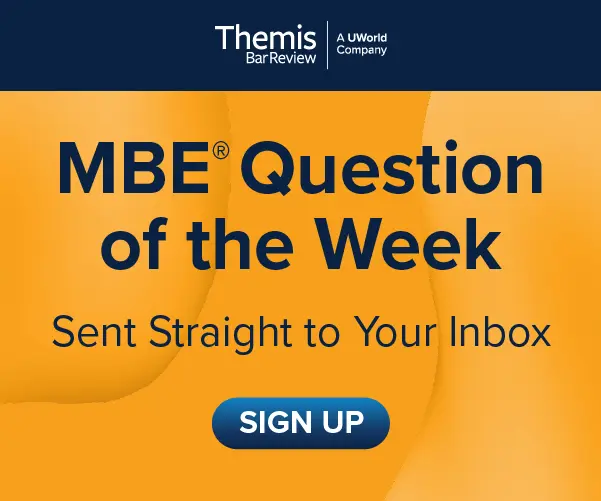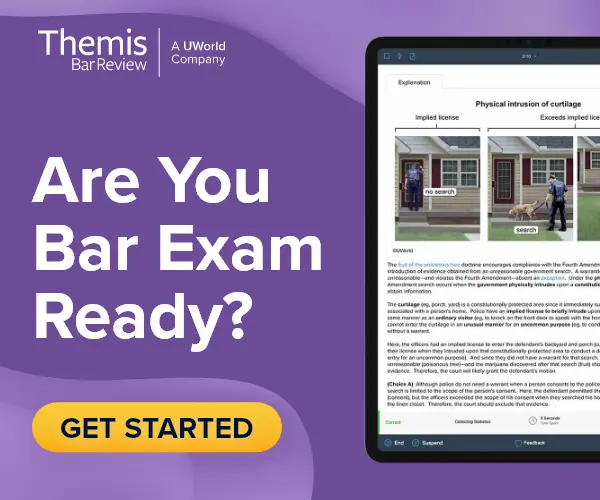The National Conference of Bar Examiners (NCBE®) administers the MPT, which constitutes 20% of the Uniform Bar Exam (UBE). While scoring varies by jurisdiction, it is typically weighted lower than the MEE (30%) and the MBE® (50%).
The MPT is highly technical and requires diligent preparation. Your performance could determine whether you pass the UBE.
Exam Format and Tested Skills
In UBE jurisdictions, the MPT consists of two 90-minute items set in the fictitious state of “Franklin.” The laws you’ve been studying do not apply here. Instead, you're provided with a "Library" of laws, a "File" of facts, and an assignment from your fictional boss. Even though Franklin and its laws are imaginary, the tasks replicate realistic assignments that newly minted lawyers must be able to complete.
MPT Task Format
Each task you’re assigned follows the same format. The facts and laws you're provided may or may not be relevant to the case. Some information may be ambiguous, incomplete, or conflicting. This feature of the MPT is designed to simulate issues you'll face in the real world and test your ability to discern and analyze.
| The File | |
|---|---|
|
Task Memo: A memorandum from your "supervising attorney," usually in the form of an email, letter, etc. This document will tell you:
Factual Documents: These may be relevant or irrelevant to the case and include:
|
|
| The Library |
The Laws: These may be relevant or irrelevant to the case and include:
|
Remember to thoroughly review everything in the library, regardless of how much you've practiced. Franklin's fictional laws routinely change from exam to exam.
MPT Task Types
Most tasks fit within 1 of 4 types. For example, a letter to a client would fit under "Opinion Letter." In rare cases, you may be tested on an unusual or "wildcard" task, such as a bench memo. If this occurs, reread the directions and use your best judgment.
| Task Type | Audience | Tone | Strong Heading Conclusions |
Goal | Frequency |
| Objective Memo |
Managing Partner | Objective | No | Resolve a legal issue | Very High |
| Persuasive Brief |
Judge | Persuasive | Yes | Persuade | High |
| Opinion Letter |
Client | Objective | No | Provide legal advice | Low |
| Demand Letter |
Opposing Counsel | Persuasive | No | Persuade to take action | Low |
The "Audience” column indicates the most common value. Every task type except for opinion letters could have an audience that is a different type of lawyer. Opinion letters are typically written for clients.
Skills You Must Perform
The NCBE designed the MPT to test the 6 following skills:
- Sort detailed factual materials and separate relevant from irrelevant facts.
- Analyze statutory, case, and administrative materials for applicable principles of law.
- Apply the relevant law to the relevant facts in a manner likely to resolve a client's problem.
- Identify and resolve ethical dilemmas when present.
- Communicate effectively in writing.
- Complete a lawyering task within time constraints.
How to Prepare for the MPT
The MPT tests your ability to think critically and follow directions while completing an assignment under time constraints. Preparation must stress practice rather than rote memorization. The efficacy of your study strategy and quality of your resources are key predictors of success.
Understand Lawyering Tasks
The NCBE expects you to be able to perform a number of lawyering tasks. On the MPT, you may be instructed to complete a:
- Memorandum to a supervising attorney
- Letter to a client
- Persuasive memorandum or brief
- Statement of facts
- Contract provision
- Will
- Counseling plan
- Proposal for settlement or agreement
- Discovery plan
- Witness examination plan
- Closing argument
Create an MPT Study Plan
An effective MPT study plan tackles exam components in manageable chunks. While your overall goal is to score well on the MPT, a sub-goal might be to understand the structure of each NCBE lawyering task. You could break down this sub-goal further by mastering each task individually. For example, you might dedicate a day to preparing closing arguments.
Create a calendar with specific daily tasks to stay organized and on track. This allows you to strategically plan your prep based on your availability and ensures you won’t miss any required exam concepts. The Themis + UWorld Full Bar Review Bundle includes an adaptive calendar to help you manage your daily tasks.
Replicate Time Constraints
In most jurisdictions, you will have 90 minutes to complete each MPT item. While it’s useful to practice without a time limit at first, you should slowly restrict your allotted time as you progress through your study plan. Eventually, try to complete items back to back. Imitating MPT time constraints will help you approach items more efficiently, reveal your weaknesses, and improve your confidence.
Give Yourself Enough Time to Study
Your MPT score accounts for about 20% of your total bar exam score. Allocate about 20% of your study time to this section. For many students, roughly 400 hours is needed to prepare for the UBE. That means you can expect to spend around 80 hours on MPT topics.
- If you’re studying full-time, begin about 8 to 10 weeks before your bar exam date. That’s 40 to 50 hours per week, with the equivalent of 1 day per week dedicated to the MPT.
- If you’re studying part-time, begin 4 to 6 months before your bar exam date. That’s 16 to 25 hours per week, with 3 to 5 hours per week spent on the MPT.
Focus on the Details
The most important tip for succeeding on the MPT is to pay attention to the details of each item.
- What am I being asked to accomplish?
- How should the document be formatted?
- Who am I writing this for?
- What facts are relevant to the case?
- Which laws are relevant to the case?
You should always keep the end product in mind as you review the information and determine what’s useful. You’ll also need to tailor your work to the appropriate audience, focusing on tone and language. As you conclude your work, don’t forget to include all necessary legal citations.
Format Your Responses
There are a lot of similarities between each MPT task type, which makes understanding distinctions crucial. In many cases, the task memo will give you very clear guidelines on what to write. Use these to create your outline and format your response. If you don't feel that the assignment gives you clear guidelines, do your best to create a structure that reflects the goal of the assignment.
Introduction
Discussion: 1 for each issue. Include a heading followed by rule, analysis, and conclusion.Conclusion: Summarize the content.
Statement of the facts
Legal argument: One for each argument. Use strong conclusions with complete sentences for headings, followed by rules, analysis, and a conclusion.Conclusion: Summarize the content
Body of the Letter: Follow IRAC. Explain the legal issues at hand.
Conclusion: Sign off according to the task’s instructions.
Body of the Letter: Follow IRAC. Explain the legal issues at hand.
Conclusion: Make your demand clear and narrow. Sign off according to the task’s instructions.
Use the IRAC Method for Legal Analysis
The IRAC format in law is based on an acronym that clarifies your reasoning and ensures you don't omit important information. Using it on the MPT will help you structure your responses in a way that’s clear to the reader.






